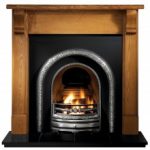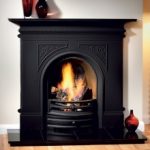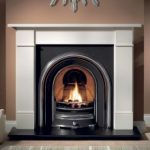
Buying a fireplace can initially appear to be a relatively straight forward task – yet an hour’s searching and you may find that finding the perfect focal point for your home is an overwhelming experience. Fear not! We’ve put together a complete guide on how to choose a fireplace, covering everything you need to know to ensure that you find the perfect fireplace that enhances your home and compliments your décor.
Initial Steps For Choosing A Fireplace
- Decide upon your budget: This should be decided before you begin shopping – Fireplaces vary in price, however there are options to suit everyone’s budgets.
- Choose your fuel type: There are many fuel types available, each with advantages and disadvantages.
- Check your chimney. Unless you are planning on making alterations, or installing a chimney it’s important that you pick a fireplace that’s suitable for your current chimney.
Select your design style to match the design of your home. - Measure up your chimney breast and decide upon the size and style Be sure to double check both your measurements to ensure a perfect fit
Fuel Types
Choosing a fuel type is an important step in buying a fireplace, though there are advantages and disadvantages to each, not everyone has access to every fuel source so it’s important that you select a source that suits your lifestyle.
Wood burning fireplaces
Wood burning fireplaces are currently witnessing a resurgence in popularity, adding a natural ambience to any household. Aside from the cosy atmosphere there are many other advantages, many are attracted to wood burning fireplaces for the price benefits as they are conventionally more cost effective than gas or electric counterparts and can also be more environmentally friendly when clean logs or pellets are used. Wood burning fireplaces aren’t for everyone however and some are put off by the need to source and stock wood and the smell of smoke in their homes.
Electric Fireplaces
Electric fireplaces create the effect of a traditional wood burning fireplace but without the need for wood. They are becoming increasingly more popular in modern homes, or apartments as they do not require a gas line or chimney. They are also popular with families, or homes that have pets as they are safer than traditional options. The disadvantages of electric fireplaces are that there are no flames thus they don’t emit as much heat as a wood burning fireplace and can’t be fitted to flat walls as they have a cast iron back, requiring a chimney breast, or false chimney breast to house the fireplace back.
Gas Burning Fireplaces
Like with electric fireplaces, choosing gas as a fuel type means that you don’t have to rely on logs as they supply a constant source of heat and can be controlled simply. As electricity is more expensive than gas they also tend to be a more cost effective way of heating a room, however they are more expensive to install and some modern homes or apartments do not have gas lines or flues. When considering gas as a fuel option you also need to consider what type of flue you have. You will have either Class 1, Class 2 or pre-cast which will determine which fireplace works with your chimney type.
Bio-Ethanol Burning Fireplaces
Bio-Ethanol is a modern fuel type that is becoming increasingly popular, largely due to the fact that they don’t require a flue as no smoke, soot or ashes are produced when burning. Ethanol burning fireplaces omit a good amount of heat, but not as much as traditional options. They tend to be slightly more expensive as you do have to buy fuel, but are very easy to use and install. Like with Electric fireplaces, these also require a recess in the wall to house the cast iron back and will not work on a flat wall.
Surrounds
Your new fireplace will be the focal point of any room, instantly serving as a beautiful statement piece and talking point thus it’s important that you choose the right material that compliments your interior and fits with the size of your room and budget. There are numerous different options to choose from, the most popular of which we’ve explained below.

Wooden Fireplaces
Wooden fireplaces are timelessly beautiful adding a traditional and sophisticated look to any home. As wood is a natural material, no two surrounds will ever be the same due to the unique knots and markings that each possesses. Wooden fireplaces are available in a number of different finishes including pine and oak and can even be customised by customers adding a stain or paint, dependent on your tastes and the other furniture in your home they can be supplied unfinished ready for this.
Cast Iron Fireplaces
Cast Iron Fireplaces are sturdy and durable and despite being considered a classic associated with the Victorian era, their elegance and intricate designs mean that they fit in any room, with any interior design style. As they are made from cast iron they age well, requiring very little maintenance, are easy to clean and long-lasting.
Limestone Fireplaces
Limestone fireplaces make a huge statement, it’s impossible to not notice their striking beauty. The pale colour of limestone means they look beautiful in rooms of all styles and as they are available in various shapes they fit with both contemporary and traditional rooms. Due to the high amounts of craftsmanship associated with the production of limestone surrounds they tend to be more expensive than other options, however they are very long lasting and as they’re created from natural stone their appearance improves and becomes more unique over time.
Fireplace Size
Once you’ve chosen your fuel type and the material you’d like for your fireplace it’s time to pick the right size. For fuel types that require ventilation via the chimney this will be based on the width of the chimney breast and you’ll want to ensure that the mantel does not exceed the chimney’s width, though you can adjust the opening if it’s a traditional brick built chimney breast. We have a follow up guide coming soon on this very topic so keep your eye out on our Facebook page or website in the meantime.






